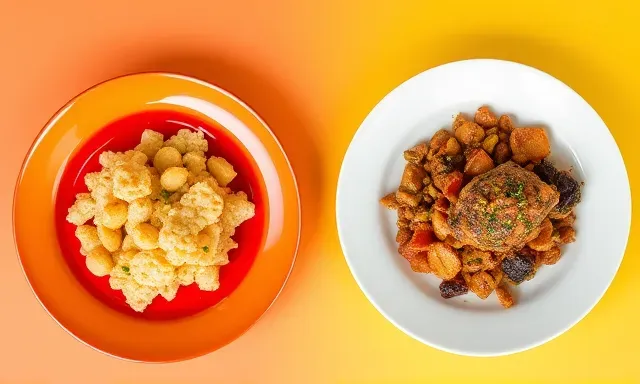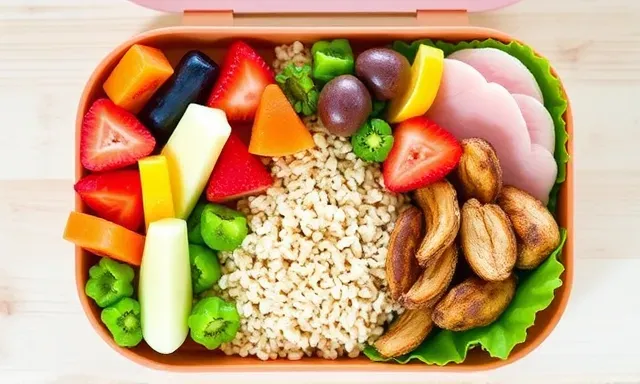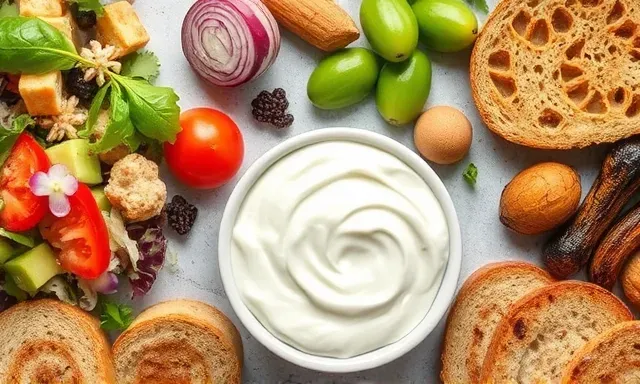What You Need to Know About Food Presentation and Psychology
"By Omar Fadil"
In the vibrant world of food, presentation isn’t just about making meals Instagram-worthy—it’s a powerful tool that can influence how we perceive taste, portion sizes, and even the healthiness of our choices. Have you ever noticed how the color of a plate can make certain foods more appealing or how arranging ingredients just right can transform simple meals into works of art? These seemingly small details have a big impact on our eating habits, often guiding our appetites and cravings without us even realizing it.
 |
| You Might Also Like: Understand and know the Tips for Sustainable Eating. |
The Impact of Plate Color on Appetite
Have you ever wondered why some meals look more appetizing on certain plates? It’s not just a coincidence—it’s science. The color of your plate can play a significant role in how much you eat and how satisfied you feel afterward. This seemingly small detail influences your brain’s perception of food in surprising ways.
Why Plate Color Matters
The psychology behind plate color stems from how the human brain processes contrasts:
- Bright contrasts increase appeal: Foods served on plates with colors that sharply contrast the dish—like spaghetti marinara on a white plate—tend to stand out, making them look more vibrant and appetizing.
- Muted tones encourage mindful eating: Soft, neutral colors, such as beige or light gray, are less stimulating. This can help reduce overeating by fostering a calm dining environment.
- Harmonious colors can enhance enjoyment: A green salad on a green plate might make the meal feel more cohesive and natural, subtly enhancing your enjoyment.
Using Plate Color to Your Advantage
You can use the psychology of color to encourage healthier eating habits:
- White plates for indulgence: Desserts like chocolate cake pop against white plates, making them look more indulgent and satisfying in smaller portions.
- Blue plates for portion control: Studies suggest that blue plates can curb overeating because blue is rarely associated with food in nature, reducing appetite.
- Green or earthy tones for healthy meals: These colors enhance the appeal of nutritious meals like salads, grilled vegetables, or whole grains by evoking a sense of freshness.
Simple Tips to Get Started
Want to experiment with plate color in your own meals? Try these easy ideas:
- Mix and match your dinnerware: Use different plate colors for various types of meals to create intentional dining experiences.
- Incorporate color psychology for kids: If your child is a picky eater, serving veggies on brightly colored plates can make them more appealing.
- Invest in versatile pieces: Neutral plates are great for everyday use, while bold hues can add a playful touch when hosting guests.
 |
| Related Reading: How to Make Seasonal Wellness Recipes |
Making Healthy Foods Look Appetizing
Let’s be honest: healthy eating doesn’t always feel exciting, especially when a bowl of veggies pales in comparison to a colorful dessert. But here’s the good news—how you present your food can completely transform how appealing it looks. With a few creative tweaks, you can make nutritious meals look just as tempting as their indulgent counterparts.
Why Presentation Matters for Healthy Foods
Presentation plays a psychological role in how we perceive taste. When healthy foods look vibrant and inviting, we’re more likely to enjoy them. It’s not just about aesthetics; it’s about creating a positive emotional response to what’s on your plate.
Tips to Make Healthy Foods More Tempting
Here are some practical strategies to make healthy meals irresistible:
Play with color combinations:
Use a mix of naturally colorful ingredients to brighten up your plate. Think:- Orange sweet potatoes paired with green broccoli.
- Red bell peppers sprinkled into a quinoa salad.
- Blueberries and strawberries atop a bowl of Greek yogurt.
Layer textures for variety:
Texture adds excitement to any dish. For example:- Top creamy soups with crunchy roasted seeds.
- Add a handful of nuts or granola to fresh fruit bowls.
- Incorporate crispy baked pita chips with your hummus dip.
Use creative plating techniques:
Present food in a way that’s visually interesting, such as:- Arrange veggie slices in a spiral or rainbow pattern.
- Stacking ingredients, like layering roasted vegetables for a colorful tower.
- Use edible garnishes like fresh herbs or lemon wedges to add flair.
The Role of Portions and Balance
Healthy meals should not only look appealing but also feel satisfying. To achieve this:
- Focus on balanced portions: Divide your plate into sections for protein, vegetables, and grains, ensuring every bite offers variety.
- Add small indulgences: A drizzle of honey or a sprinkle of dark chocolate can elevate even the simplest dishes.
Bento Boxes: A Fun Solution for Everyone
If you’re packing lunches, consider using a bento box for a fun, organized presentation. Each compartment allows you to create a balanced meal with variety and vibrant appeal. For example:
 |
| Also Read: What You Need to Know About Eating for Emotional Resilience |
- A section of sliced fruit.
- A handful of whole-grain crackers.
- Bite-sized veggie sticks with a small portion of dip.
By taking the time to make your healthy meals visually appealing, you’re not just feeding your body—you’re delighting your senses. Healthy eating can be just as enjoyable as it is nutritious, with presentation as your secret ingredient.
Visual Tricks to Eat Smaller Portions
Have you ever felt like you’ve eaten more than you intended, simply because the food was right there? Portion sizes can be deceiving, but what if you could trick your mind into feeling satisfied with less? By making simple changes to how you serve and present food, you can enjoy smaller portions without feeling deprived.
Why Visuals Influence Portion Perception
The way food is presented can directly impact how much you eat. Studies show that our brains rely heavily on visual cues to determine fullness, meaning your eyes often dictate how much your stomach thinks it needs.
Smart Visual Tricks for Portion Control
Here are a few clever ways to use presentation to your advantage:
Choose smaller plates and bowls:
- A smaller plate makes portions appear larger, helping you feel more satisfied.
- Using a smaller bowl for snacks like nuts or popcorn can prevent mindless overeating.
Focus on high-volume foods:
- Foods with a high water content, like salads or soups, take up more space on your plate while keeping calories low.
- Arrange your plate to prioritize vegetables, making your meal visually abundant.
Portion food before serving:
- Instead of eating directly from a bag or box, serve a portion in a small dish. This creates a clear visual stop point.
Space out your food:
- Spread out smaller portions across the plate to give the illusion of more food.
- Use garnishes or side items to fill empty spaces and add visual interest.
Incorporating Mindful Eating Techniques
Beyond presentation, mindful eating can further enhance satisfaction:
- Slow down and savor each bite: Putting your fork down between bites can help your brain catch up with your stomach.
- Appreciate the presentation: Before you dig in, take a moment to admire the colors, textures, and arrangement on your plate.
- Listen to your body: Stop eating when you feel satisfied, not stuffed.
Creative Serving Ideas for Everyday Meals
If you’re looking for inspiration to start, try these ideas:
- Use ramekins for individual portions of desserts or snacks.
- Serve pasta dishes on wide, flat plates with a smaller portion surrounded by a vibrant salad.
- Arrange fruits or veggies in a fun pattern, such as a spiral or grid, to make even small amounts feel exciting.
 |
| You May Also Like: How to achieve a specific health result.s |
Bento Box Ideas for Balanced Meals
Do you ever find yourself struggling to pack lunches that are both nutritious and appealing? Bento boxes could be the perfect solution. Inspired by traditional Japanese lunchboxes, they combine practicality with creativity, making it easy to create balanced, visually appealing meals that are as fun to eat as they are to look at.
Why Bento Boxes Are Ideal for Balanced Eating
Bento boxes naturally encourage portion control and variety. With their individual compartments, you can include multiple food groups in a single meal, ensuring balance without the risk of mixing flavors or textures. They’re great for kids and adults alike, offering a portable way to enjoy wholesome meals on the go.
Building a Balanced Bento Box
To craft the perfect bento box, focus on variety and balance:
Choose a base of complex carbohydrates:
- Options like brown rice, quinoa, or whole-grain pasta provide lasting energy.
- For a lower-carb option, use cauliflower rice or zoodles.
Add a protein source:
- Include lean proteins like grilled chicken, boiled eggs, tofu, or legumes.
- Try fun alternatives like teriyaki salmon bites or mini turkey meatballs.
Include colorful vegetables:
- Chop fresh veggies like carrots, cucumber, and bell peppers into bite-sized pieces.
- Lightly steam broccoli or green beans for a softer texture.
Incorporate healthy fats:
- Add a small portion of nuts, avocado slices, or a drizzle of olive oil dressing.
- Include seeds like chia or sesame for an extra nutritional boost.
Don’t forget a treat or fruit:
- Balance the meal with a sweet note, such as fresh berries, apple slices, or a square of dark chocolate.
- Use silicone cupcake liners to separate treats and keep everything tidy.
Creative Ideas for Bento Box Themes
If you want to make your bento boxes even more fun, try these themed ideas:
Mediterranean Delight:
- Hummus with veggie sticks, falafel bites, tabbouleh, and a side of olives and feta cheese.
Breakfast Bento:
- Hard-boiled eggs, whole-grain toast triangles, Greek yogurt with berries, and a sprinkle of granola.
Snack Bento for Kids:
- Mini cheese cubes, whole-grain crackers, fresh grapes, and a small portion of dark chocolate chips.
Practical Tips for Bento Box Success
To make the process easier:
 |
| Also Read: Know food trends and innovations. |
- Prep ahead: Chop fruits and veggies in advance, and store them in airtight containers.
- Invest in a good bento box: Look for one that’s leakproof, easy to clean, and has multiple compartments.
- Keep it fresh: Use ice packs or insulated bags to maintain freshness, especially for perishable items.
Bento boxes make it easy to bring variety, nutrition, and creativity to your meals. Whether you’re packing lunch for work, school, or a picnic, they turn a simple meal into a delightful experience, ensuring that every bite is balanced and enjoyable.
The Role of Texture in Satisfying Cravings
Have you ever noticed how the texture of food can influence how satisfying it feels? Whether it’s the crunch of a crisp apple, the creaminess of mashed potatoes, or the chewiness of a fresh baguette, texture plays a pivotal role in how we experience food. By understanding and utilizing texture, you can enhance meals and even manage cravings more effectively.
How Texture Influences Appetite and Satisfaction
Texture is more than just a sensory detail—it’s a psychological cue. Foods with varying textures can:
- Increase satisfaction: A variety of textures keeps meals interesting, preventing boredom and overeating.
- Affect satiety: Chewy or fibrous foods take longer to eat, giving your brain more time to register fullness.
- Trigger emotional connections: Certain textures, like creamy or crunchy, may remind you of comfort foods or happy memories.
Tips for Using Texture to Balance Cravings
If you’re looking to satisfy cravings without derailing your nutrition goals, consider these strategies:
Add crunch to meals:
- Incorporate nuts, seeds, or roasted chickpeas for a satisfying crunch.
- Swap fried snacks for baked alternatives like kale chips or air-popped popcorn.
Blend creamy and crisp textures:
- Pair creamy hummus with crunchy veggie sticks or crackers.
- Top a salad with creamy avocado and toasted nuts for a balanced mouthfeel.
Chew your way to satiety:
- Choose whole fruits over juices; the natural fiber adds texture and slows down consumption.
- Opt for whole grains like farro or barley instead of refined grains to introduce more chewiness.
Experiment with temperature contrasts:
- Combine warm and cool elements, like warm roasted veggies over chilled quinoa.
- Add a dollop of cold yogurt to spicy, hot chili for a satisfying temperature play.
The Psychology Behind Texture Preferences
Our personal cravings often align with certain textures:
- Creamy textures: Often associated with comfort and indulgence, like ice cream or mashed potatoes.
- Crunchy textures: Linked to excitement and satisfaction, often found in chips or toasted nuts.
- Chewy textures: These can evoke feelings of grounding and substance, making meals feel more filling.
Understanding these preferences can help you make intentional choices. For example:
 |
| See Also: What You Need to Know About Community-Focused Nutrition |
- When craving chips, try crunchy vegetable sticks with dip.
- If you’re drawn to creamy textures, a bowl of Greek yogurt with honey can be a healthier alternative to heavy cream-based desserts.
Enhancing Texture in Everyday Meals
Here are some simple ways to elevate texture in your cooking:
- Garnish dishes: Sprinkle toasted seeds, nuts, or croutons for added crunch.
- Use layers: Create parfaits or layered casseroles to combine soft, crunchy, and creamy textures.
- Roast and grill: These methods add a crisp, caramelized surface while keeping the inside tender.
A Balanced Approach to Texture
Incorporating a mix of textures into your meals doesn’t just enhance enjoyment—it can help you create balanced, nourishing plates that leave you feeling satisfied. By experimenting with textures, you can transform even the simplest dishes into dynamic, crave-worthy experiences. So next time you plan a meal, think about not just the flavors but also the textures that will bring it to life.
Wrapping It All Up: The Power of Food Presentation and Psychology
Who knew the way food looks, feels, and is presented could wield so much influence over our eating habits and overall satisfaction? As we’ve explored, factors like plate color, texture, and even the visual appeal of balanced meals can make all the difference in shaping not just what we eat but how much we enjoy it.
By paying closer attention to these often-overlooked details, you have the power to transform your relationship with food. Imagine making healthier choices because they genuinely excite you or managing portions effortlessly through simple visual tricks. Whether it’s crafting Instagram-worthy bento boxes or experimenting with textures that satisfy cravings, these small changes add up to big impacts.
Now, take a moment to consider your next meal. How can you use the concepts of food presentation and psychology to create an experience that feels both nourishing and enjoyable? Is there a dish you’ve always wanted to elevate or a craving you’d like to manage better?
As you bring these ideas to your table, remember that even the smallest tweaks—like choosing vibrant plates or layering textures—can make a big difference. Food is more than sustenance; it’s an experience, a connection, and a reflection of how we care for ourselves and those around us.
So go ahead, have fun with your meals. Get creative, experiment with colors, play with textures, and embrace the psychology behind every bite. After all, eating isn’t just about the food itself—it’s about how we feel when we enjoy it.
Here’s to meals that aren’t just good for the body but also a feast for the eyes and the soul. Enjoy your food!
References:
The Influence of Plate Color on Appetite and Food Choices
- Source: An article discussing how red plates can increase hunger and lead to more ravenous eating.
Food Presentation and Its Impact on Appetite
- Source: An article exploring how artistic plating can enhance the enjoyment of food.
Psychology of Eating and Portion Control
- Source: A discussion on how food presentation can affect eating habits and health.
Bento Boxes and Balanced Meals
- Source: An article discussing the relevance of food presentation and its impact on eating habits.
Food Texture and Satisfying Cravings
- Source: An article discussing how food presentation influences taste perception and enhances the dining experience.

